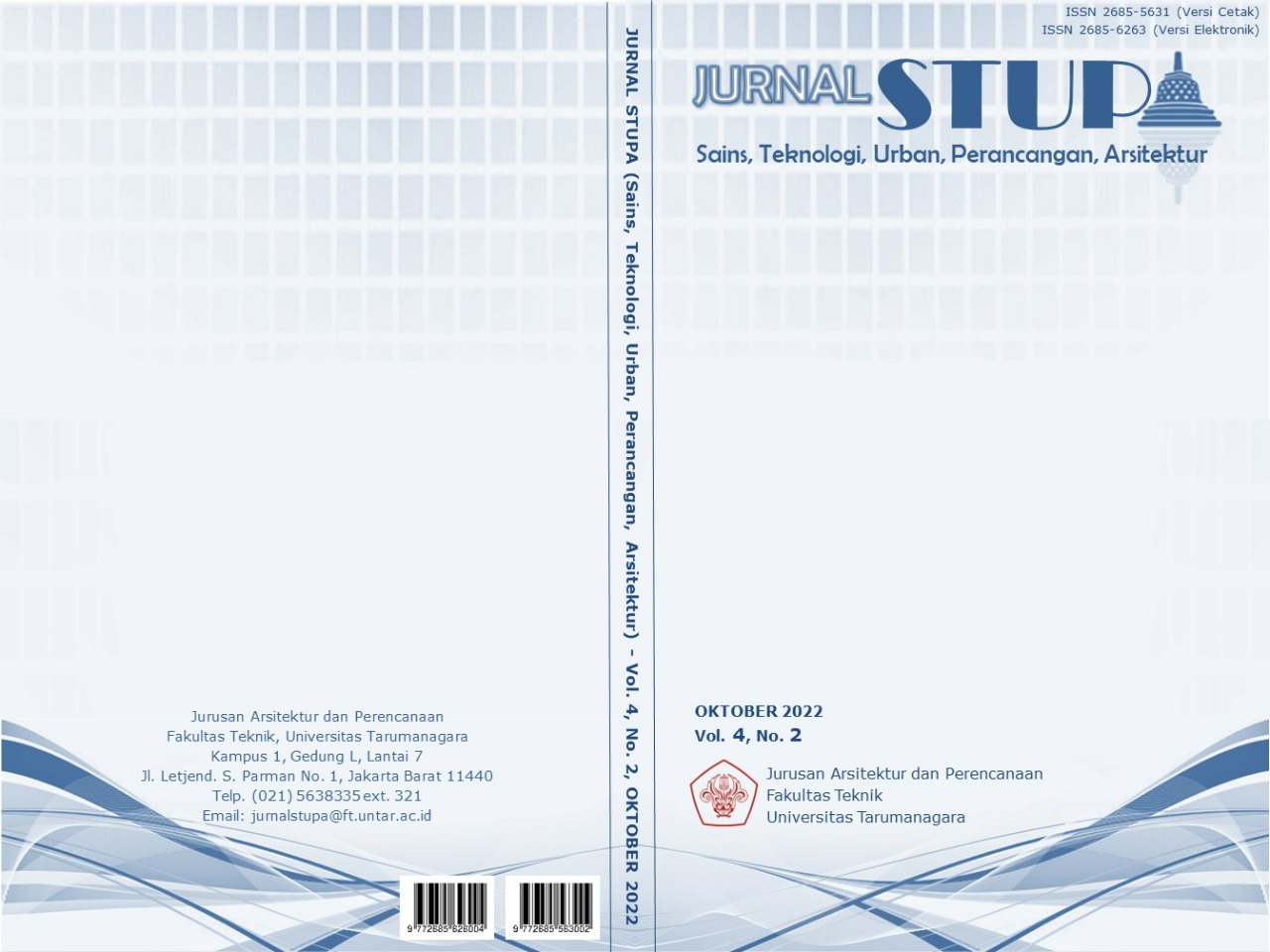KEBUTUHAN SISTEM MODULAR PADA BANGUNAN HIGH DENSITY
Main Article Content
Abstract
The population density in big cities like Jakarta always increases every year. If this continues, the need for housing will be increasingly challenging to meet. Dukuh Atas is the sub-district with the highest proportion of slums and dense settlements in DKI Jakarta. The Dukuh Atas area is located between the Jakarta business triangle area, which is traversed by three modes of transportation, and there are residential areas that have the potential to become a place for various community functions and activities to meet. According to the DKI Jakarta Spatial Planning (RTRW), the Dukuh Atas area is directed to become a Transit Oriented Development (TOD) area. However, the application of the TOD concept in the Dukuh Atas area is still not optimal because low-intensity settlement functions still dominate it. Vertical housing is one solution to the problem of density and housing needs in big cities, but vertical housing (rusunawa) in the Dukuh Atas area is still not optimal. In addition to lighting and ventilation, the type that does not vary and its massive shape causes residents who are already married to be forced to live in dwellings with a limited area and not following their needs. Therefore, this research will investigate how the architectural program can provide flexible housing for the community to be comfortable and livable. The urban acupuncture approach can increase productivity in empowering residents of sustainable settlements and is expected to become a residence with positive synergy.
Keywords: Flexibility; Urban Acupuncture; Vertical Residential Houses
Abstrak
Kepadatan penduduk di kota besar seperti Jakarta selalu meningkat setiap tahunnya. Dimana jika hal ini terus berlanjut maka kebutuhan tempat tinggal akan semakin sulit terpenuhi. Dukuh Atas merupakan kecamatan dengan proporsi pemukiman kumuh dan padat tertinggi di DKI Jakarta. Kawasan Dukuh Atas berada diantara kawasan segitiga bisnis Jakarta yang dilalui oleh tiga moda transportasi dan terdapat hunian yang berpotensi menjadi wadah untuk bertemunya berbagai fungsi dan aktivitas masyarakat. Menurut Rencana Tata Ruang Wilayah DKI (RTRW) Jakarta Kawasan Dukuh Atas diarahkan menjadi kawasan Transit Oriented Development (TOD). Namun penerapan konsep TOD di kawasan Dukuh Atas masih belum optimal karena masih didominasi oleh fungsi permukiman dengan intensitas rendah. Hunian vertikal merupakan salah satu solusi dari masalah kepadatan dan kebutuhan hunian di kota besar, tetapi perumahan vertikal (rusunawa) yang ada di Kawasan Dukuh Atas masih belum optimal. Selain penerangan dan ventilasi, tipe yang tidak bervariasi dan bentuknya yang masif menyebabkan penghuni yang sudah berkeluarga terpaksa tinggal di hunian dengan luas yang terbatas dan tidak sesuai dengan kebutuhannya. Oleh karena itu, riset ini akan menginvestigasi bagaimana program arsitektur mampu menyediakan tempat tinggal yang fleksibel bagi masyarakat sehingga nyaman dan layak untuk dihuni. Dengan pendekatan urban acupuncture dapat meningkatan produktivitas dalam pemberdayaan penghuni permukiman yang berkelanjutan dan diharapkan dapat menjadi hunian yang bersinergi positif.
Article Details

This work is licensed under a Creative Commons Attribution-NonCommercial-ShareAlike 4.0 International License.
This work is licensed under a Jurnal Sains, Teknologi, Urban, Perancangan, Arsitektur/ STUPA Creative Commons Attribution-NonCommercial-ShareAlike 4.0 International LicenseReferences
Casagrande, M. (2014). Paracity: Urban Acupuncture. 9-20.
Das, M., Angeli, F., & Schayck, O. C. P. (2020). International Journal of Policy Sciences and Law. An Analysis of Mental Health, 1001-1023.
Fauzia, A. N., Handajani, R. P., & Nugroho, A. M. (2014). Fleksibilitas Interior Unit Hunian pada Rumah Susun di Kota Malang.
Jaiganesh, K., Dinesh, S., & Preetha, R. (2016). IRJET Journal. A COMPREHENSIVE REVIEW ON LOW COST BUILDING SYSTEMS, 429-433.
Lerner, J. (2014). Urban Acupuncture. Island Press.
Murni, A. M., & Samodra, F. B. (2017). International Seminar on Science and Technology. Novel Translation for Sustainable Vertical .
Nursyahbani, R., & Pigawati, B. (2005). KAJIAN KARAKTERISTIK KAWASAN PEMUKIMAN KUMUH DI KAMPUNG KOTA. 1-2.
Sutanto, A. (2020). PETA METODE DESAIN. Jakarta.
Bertram, N., Fuchs, S., Mischke, J., Palter, R., Strube, G., & Woetzel, J. (2019, June). https://www.mckinsey.com/. Retrieved from Modular: https://www.mckinsey.com/~/media/mckinsey/business%20functions/operations/our%20insights/modular%20construction%20from%20projects%20to%20products%20new/modular-construction-from-projects-to-products-full-report-new.pdf



